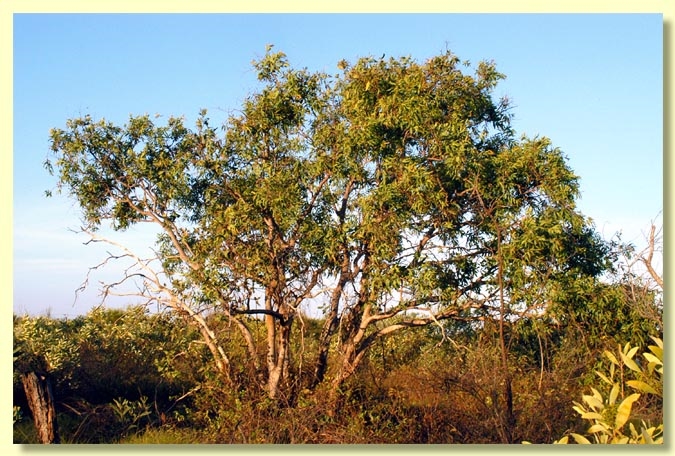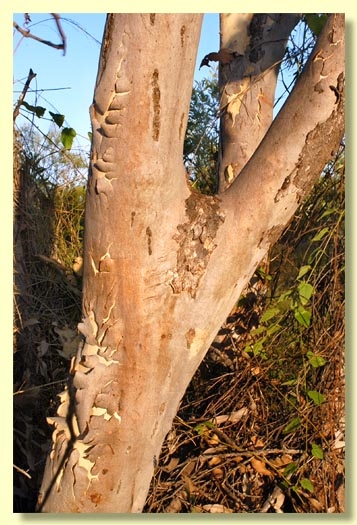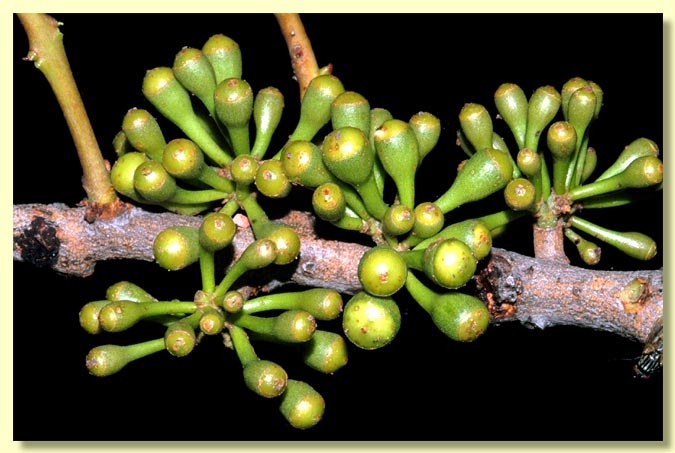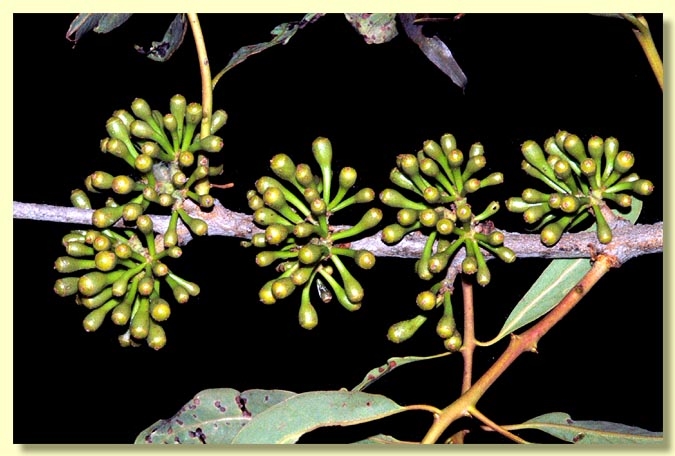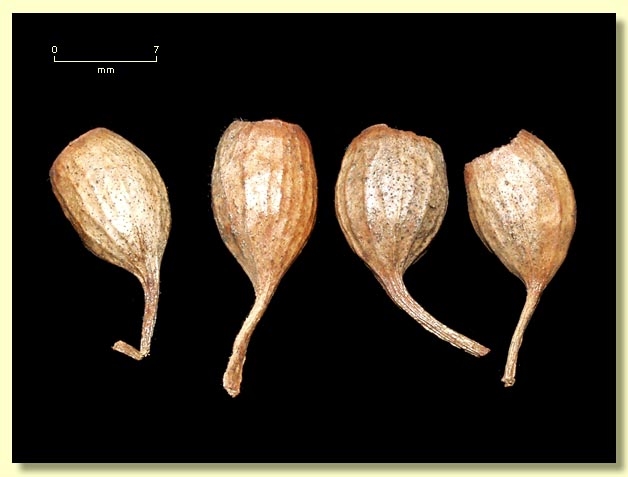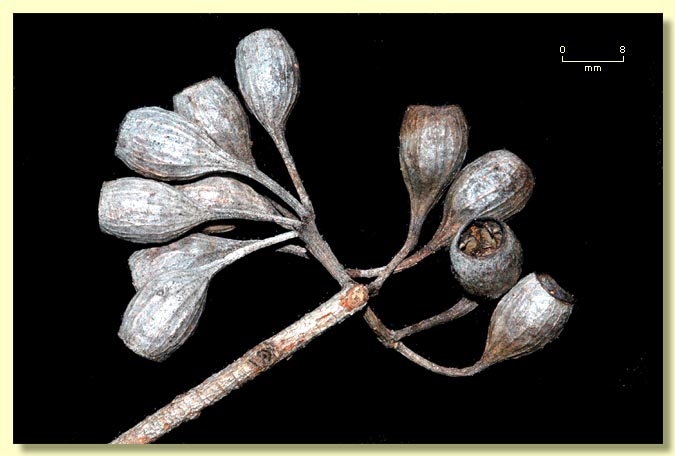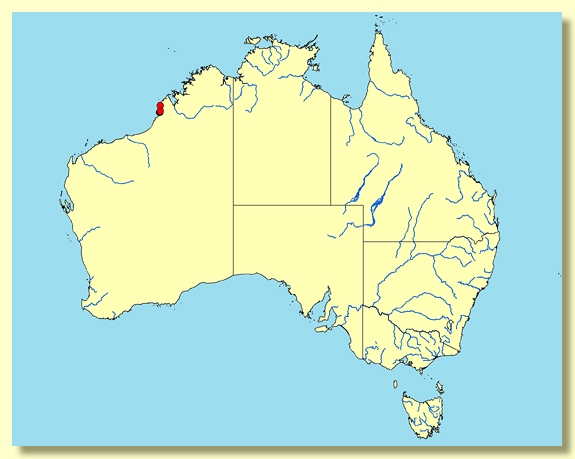Corymbia | Blakearia
Euclid - Online edition
Corymbia paractia
Tree 8 m tall, deciduous in the dry season. Forming a lignotuber.
Bark rough and thinly persistent on the lower ca 0.5 m of trunk, flaky or ± tessellated and brownish grey, or smooth throughout, creamy white to pale grey.
Branchlets sometimes have oil ducts visible in the pith; younger branchlets glabrous or sometimes scabrid to setose with bristle-glands. In this species the bristle-glands bear simple hairs (i.e. the bristle-glands appear branched).
Juvenile growth (coppice or field seedlings to 50 cm): stems rounded in cross-section, setose with bristle-glands; juvenile leaves always petiolate, opposite, ovate-elliptic, 5–11 cm long, 4–6 cm wide, base usually rounded or sometimes very slightly lobed, apex broadly pointed, margin entire or distantly subcrenulate, green, dull, setose with bristle-glands.
Crown of intermediate and adult leaves, opposite or alternate, always petiolate, petioles 0.4–1.2 cm long; blade lanceolate, (4.8)7.5–14 cm long, 1.4–5.5(7) cm wide, ± undulate, base tapering, less commonly lobed or rounded, margin entire, apex broadly pointed or almost rounded, concolorous, dull, green, glabrous or (on broader leaves) sparsely setose with bristle-glands, side-veins at greater than 45° to midrib, reticulation dense to very dense, intramarginal vein present, oil glands obscure.
Inflorescence borne on leafless branchlets below new season’s leaf growth, axillary compound, the rhachis consisting of a basal internode ca 0.2–0.5 cm long, a second internode absent or to 0.3 cm long, sometimes a third and a fourth internode ca 0.2 cm long, and peduncles of variable length within a single inflorescence, 0.1–0.8 cm long, buds 3 and 7 per umbel, pedicels 0.5–1.5 cm. Mature buds pyriform, 0.5–0.7 cm long, 0.4–0.5 cm wide, smooth, scar present (outer operculum shed early), operculum shallowly rounded and sometime apiculate, stamens inflexed, all fertile, anthers oblong, dorsifixed, versatile, dehiscing by longitudinal slits, style long and straight, stigma tapered, locules 3, the ovules not arranged in distinct vertical rows on the placentae. Flowers creamy white.
Fruit pedicellate (pedicels 0.6–1.5 cm long), cupular to barrel-shaped or cylindrical, rarely obconical, 0.7–1.1 cm long, 0.6–0.9 cm wide, thin-walled, disc descending vertically, valves 3, enclosed.
Seeds brown, saucer-shaped, smooth, hilum ventral.
Cultivated seedlings (measured at ca node 10): not grown
Flowering has been recorded in November and December.
A low-growing ghost gum tree endemic to the Kimberley region of Western Australia, and of restricted distribution in the Broome area north towards Cape Bertholet, where it is found occupying the zone between coastal sand dunes and the red Pindan soils immediately behind the dunes. Corymbia paractia can be single or multi-stemmed, with smooth bark or a short patchy stocking of thin flaky rough bark, a crown with a variable mixture of broader setose intermediate leaves and with glabrous, narrowly lanceolate adult leaves. It is ± deciduous in the dry season and flowers when new leaf growth starts. The inflorescence is variably congested to weakly expanded, having a short basal internode and sometimes one to three further very short internodes. Buds have pedicels 0.5–1.5 cm long.
Hill & Johnson (1995) named this species Corymbia paractia, (Corymbia section Blakearia), regarding it as a stabilized hybrid between C. flavescens and C. dendromerinx. Both these species of ghost gum occur in the general south-western Kimberley area adjoining but not in the precise habitat occupied by populations of C. paractia, which thus seems to fill a niche neither of the parents can fill.
The combination of low-growing habit, narrow, green, glabrous, fully adult leaves, moderately to strongly pedicellate buds and fruit, and precise habitat distinguish it from both purported parents, viz C. flavescens, with its smooth bark and coarse, broad, yellow-green, glabrous, semi-glossy adult leaves, and condensed inflorescence with shortly pedicellate buds; and C. dendromerinx, with its smooth to scaly trunk, broad, cordate, setose adult leaves, condensed inflorescence and long-pedicellate buds. C. paractia is very similar to another ghost gum, C. clavigera, known with surety only from the remote north-western Kimberley coast. C. clavigera has a crown of glabrous, fully adult leaves and inhabits sites where the underlying geology is volcanic (basalt). The only other ghost gum in the south-western Kimberley region likely to be confused is C. bella, a taller more erect tree than C. paractia, with smooth bark, a crown of narrow, green, glabrous adult leaves and an obviously expanded axillary inflorescence with internodes clearly visible and buds in pedunculate clusters of three.
MORE ABOUT CORYMBIA
MORE ABOUT GHOST GUMS
Corymbia paractia: Greek paraktios, on the seaside, referring to its habitat.

